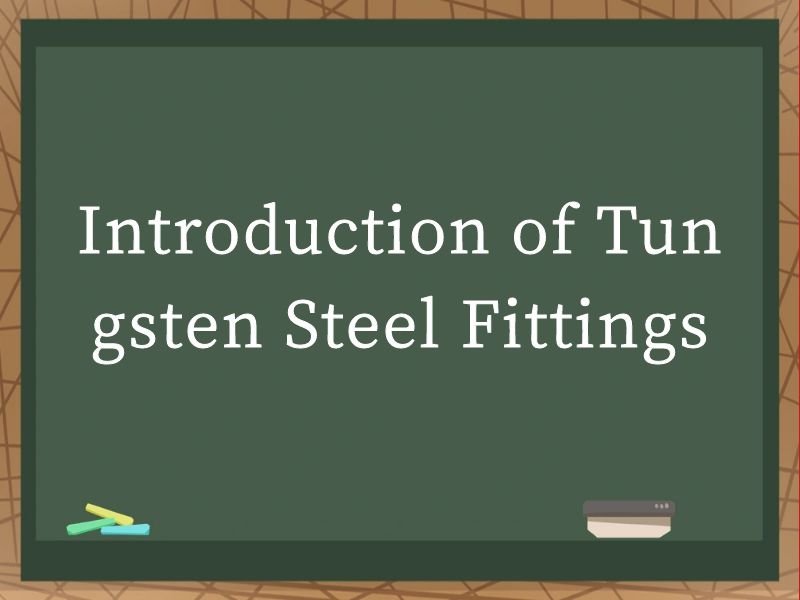JOURNALISM
- NEWS -
|
Introduction of Tungsten Steel FittingsIntroduction of Tungsten Steel Fittings.Tungsten steel, also known as high-speed steel, is renowned for its exceptional hardness, wear resistance, and ability to retain its sharpness at elevated temperatures. These properties make tungsten steel an ideal material for creating fittings that need to endure rigorous and demanding applications. Tungsten steel fittings are widely used in various industries, including machinery, tooling, aerospace, and automotive, where precision, durability, and reliability are paramount.
Composition and Properties Tungsten steel's unique composition primarily consists of tungsten, carbon, chromium, vanadium, molybdenum, and cobalt. Tungsten, being the heaviest metal on Earth after gold, platinum, and osmium, contributes significantly to the alloy's hardness and density. Carbon enhances the steel's ability to form hard carbides, while chromium, vanadium, and molybdenum improve its corrosion resistance and high-temperature strength. Cobalt acts as a binder metal, ensuring that the alloy maintains its structural integrity at elevated temperatures. These components collectively result in a material that is capable of maintaining its hardness up to temperatures of around 600°C (1112°F). Tungsten steel's hardness is measured on the Rockwell scale, typically ranging from 63 to 67 HRC, which is significantly higher than that of conventional stainless steel or tool steel. This hardness, coupled with its excellent wear resistance, makes tungsten steel fittings highly resistant to deformation and abrasive wear. Manufacturing Processes The production of tungsten steel fittings involves several sophisticated manufacturing processes. The raw materials are first melted in an electric arc furnace under controlled conditions to ensure a homogeneous alloy composition. Once the molten metal has cooled and solidified, it undergoes a series of forging and rolling operations to shape it into the desired forms, such as bars, rods, or tubes. Heat treatment is a crucial step in the manufacturing process of tungsten steel fittings. It involves heating the alloy to critical temperatures, followed by rapid cooling, to induce the desired microstructural changes. This process, known as quenching, enhances the hardness and wear resistance of the material. Subsequent tempering operations at lower temperatures relieve internal stresses and improve the alloy's toughness, ensuring a balance between hardness and ductility. Machining and finishing are the final stages in the production of tungsten steel fittings. Precision machining operations, such as milling, turning, and drilling, are employed to achieve the exact dimensions and tolerances required for specific applications. Surface finishing techniques, such as grinding and polishing, enhance the aesthetic appeal and functional performance of the fittings by removing any surface defects and achieving a smooth, uniform texture. Applications in Machinery and Tooling In the machinery and tooling industries, tungsten steel fittings are indispensable for creating cutting tools, drills, taps, and dies. The hardness and wear resistance of tungsten steel enable these tools to maintain their sharpness and accuracy over extended periods of use, significantly reducing the need for frequent sharpening or replacement. Tungsten steel dies, for instance, are used in the metal forming process to shape and cut materials like sheet metal and wire. Their ability to withstand high pressures and temperatures ensures that the formed parts meet the required specifications with minimal waste and defects. Similarly, tungsten steel drills are employed in drilling operations across various sectors, from aerospace to automotive, where precision and efficiency are essential. Role in Aerospace Engineering The aerospace industry demands materials that can endure extreme conditions, such as high temperatures, high pressures, and corrosive environments. Tungsten steel fittings are well-suited for these applications due to their exceptional mechanical properties and thermal stability. In aircraft engines, tungsten steel components are used in the turbine section, where they withstand the high temperatures and centrifugal forces generated during operation. Tungsten steel fittings are also employed in landing gear systems, providing the necessary strength and durability to support the aircraft during takeoff, landing, and taxiing. Moreover, tungsten steel is used in the manufacturing of precision instruments and sensors, which are crucial for the navigation and control systems of aerospace vehicles. The material's ability to maintain its dimensional stability and performance under harsh conditions ensures the reliability and accuracy of these instruments. Automotive Industry Applications The automotive industry has also benefited significantly from the use of tungsten steel fittings. In engine manufacturing, tungsten steel is used to create valve seats and guides, which must endure the constant friction and high temperatures associated with internal combustion. The hardness and wear resistance of tungsten steel ensure that these components maintain a tight seal and smooth operation over the engine's lifetime. Tungsten steel is also used in the production of gears and transmission components, where its ability to withstand high loads and maintain precision is crucial. In addition, tungsten steel fittings are employed in braking systems, particularly in high-performance vehicles, where they provide enhanced durability and heat resistance. Advancements and Innovations Recent advancements in material science and manufacturing technology have led to the development of new tungsten steel alloys with even higher hardness, wear resistance, and thermal stability. These alloys often incorporate additional elements, such as niobium and tantalum, to further enhance their properties. Innovations in heat treatment processes have also contributed to the improvement of tungsten steel fittings. Techniques such as vacuum quenching and cryogenic treatment are now being employed to achieve more consistent and predictable microstructural changes, leading to enhanced mechanical properties and longer service lives. Moreover, advancements in machining and finishing technology have enabled the production of tungsten steel fittings with tighter tolerances and smoother surfaces. This has expanded the range of applications for tungsten steel, making it suitable for even more demanding and precision-critical tasks. Environmental and Sustainability Considerations Despite their exceptional performance, tungsten steel fittings are not without their environmental concerns. The mining and processing of tungsten ore can have significant impacts on the environment, including soil contamination, water pollution, and habitat destruction. Additionally, the disposal of tungsten steel waste can pose challenges due to the material's hardness and durability. Efforts are being made to address these concerns through the development of more sustainable mining and processing techniques. Researchers are exploring new methods for extracting tungsten from ore with reduced environmental impact, as well as developing recycling processes for tungsten steel waste. Manufacturers are also increasingly adopting eco-friendly manufacturing practices, such as using renewable energy sources, reducing waste generation, and implementing waste management programs. These initiatives aim to minimize the environmental footprint of tungsten steel fittings while ensuring their continued availability and performance. Conclusion in a Different Form Tungsten steel fittings stand as a testament to the incredible capabilities of modern materials science. Their unique combination of hardness, wear resistance, and thermal stability makes them indispensable in a wide range of industries, from machinery and tooling to aerospace and automotive. As advancements continue to be made in material development, manufacturing processes, and environmental sustainability, the applications and potential of tungsten steel fittings will undoubtedly expand. The journey of tungsten steel from raw material to finished fitting is a testament to human ingenuity and the relentless pursuit of excellence. From the controlled conditions of the electric arc furnace to the precision machining and finishing operations, each step in the production process is critical to achieving the final product's exceptional performance. As we look to the future, it is clear that tungsten steel fittings will continue to play a pivotal role in driving innovation and progress across various sectors. Their ability to endure rigorous and demanding applications, while maintaining precision and reliability, makes them an invaluable asset in the quest for efficiency, durability, and sustainability. |


